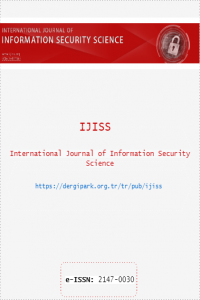Enhancing Network Security for Image Steganography by Splitting Graphical Matrix
Enhancing Network Security for Image Steganography by Splitting Graphical Matrix
The proposed work has focused on the security of image in order to save it from external attacks. However there have been several existing steganography mechanisms to secure the graphical contents but there are still threats from external attacks. Moreover in case of bulky image it becomes difficult to shift content over network without any loss. Thus proposed work has been introduced to allow graphical splitter mechanism to break graphical content in multiple parts by splitting image matrix in two or multiple parts according to image size. If the image size is less bulky, it could be split into just two parts or if the image size is more bulky, it could be split into more than two or multiple parts. This would save the image from being hacked or read in unauthentic manner. The proposed work would apply a key to divide image matrix in two or more than two parts so that it could not be easily understood. The proposed work is also concentrated on Threats to security, Nature of attacks, and Delay in pre-processing. It also focused on Delay during the process of encryption and decryption, Image Quality. Moreover there are several compression techniques to compress the graphical contents to increase the transmission speed. The proposed work has compared traditional compression mechanism with present splitting mechanism that would reduce the size of image along with providing security.
Keywords:
Steganography, Encryption Image processing, Image compression,
___
- [1] T. J. Ogundele and A. O. Adetunmbi, ”Evaluation of Multi Level System of Steganography”, International Journal of Information Security Science, 3(4), December 2014.
- [2] I. Karadogan and R. Das, ”An Examination on Information Hiding Tools for Steganography”, International Journal of Information Security Science, 3(3), September 2014.
- [3] V. K. Pant, J. Prakash and A. Asthana, ”Three step data security model for cloud computing based on RSA and steganography”, International Conference on Green Computing and Internet of Things (ICGCIoT), pp. 490-494, Noida, India, 2015.
- [4] R. Kaur and J. Kaur, ”Cloud computing security issues and its solution: A review,” 2nd International Conference on Computing for Sustainable Global Development (INDIACom), pp. 1198- 1200, New Delhi, India, 2015.
- [5] F. Mary and D. I. G. Amalarethinam, ”Data Security Enhancement in Public Cloud Storage Using Data Obfuscation and Steganography”, World Congress on Computing and Communication Technologies (WCCCT), pp. 181-184, Tiruchirappalli, India, 2017.
- [6] Ataussamad, R. Singh and S. Prakash, ”Enhancement of steganography using K strange point clustering”, International Conference on Innovations in Information, Embedded and Communication Systems (ICIIECS), pp. 1-5, Coimbatore, India, 2017.
- [7] A. A. Abd El-Latif, B. Abd-El-Atty, M. S. Hossain, S. Elmougy and A. Ghoneim, ”Secure Quantum Steganography Protocol for Fog Cloud Internet of Things”, in IEEE Access, volume 6, pp. 10332-10340, 2018.
- [8] J. Zeng, S. Tan, G. Liu, B. Li and J. Huang, “WISERNet: Wider Separate-then-reunion Network for Steganalysis of Color Images,” IEEE Transactions on Information Forensics & Security, Revised Version 2, p. 99, 2019.
- [9] Y. Yeung, W. Lu, I. Y. Xue, J. Huang and Y. Q. Shi, “Secure Binary Image Steganography with Distortion Measurement Based on Prediction”, IEEE Transactions on Circuits and Systems for Video Technology, pp(99):1-1, 2019.
- [10] A. Y. AlKhamese, W. R. Shabana and I. M. Hanafy, ”Data Security in Cloud Computing Using Steganography: A Review”, International Conference on Innovative Trends in Computer Engineering (ITCE), pp. 549 – 558, 2019.
- [11] A. Mukerjee, S. Som, S. K. Khatri and A. Mathur, ”Enhancing Remembrance of Password as an Image”, Amity International Conference on Artificial Intelligence (AICAI), pp. 198 – 203, 2019.
- [12] V. Gasimov, “The Modified Method of the Least Significant Bits for Reliable Information Hiding in Graphic Files”, International Journal of Information Security Science, 8(1), pp. 1-10, March 2019.
- Yayın Aralığı: Yılda 4 Sayı
- Başlangıç: 2012
- Yayıncı: Şeref SAĞIROĞLU
Sayıdaki Diğer Makaleler
A Description Logic Ontology for Email Phishing
Franklin TCHAKOUNTÉ, Djeguedem MOLENGAR, Justin Moskolai NGOSSAHA
Incorporating Differential Privacy Protection to a Basic Recommendation Engine
SLAAC Attack Detection Mechanism
Nazrool Bin OMAR, Selvakumar MANİCKAM
Enhancing Network Security for Image Steganography by Splitting Graphical Matrix
